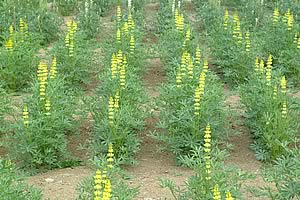22/09/06
A realistic home-grown alternative to imported protein sources
has taken a step closer, thanks to an on-going five-year project
being carried out as part of the DEFRA Sustainable Arable LINK
Scheme.
Lupins look set to be a valuable home-grown
protein source for UK livestock farmers
 |
The Lupins in Sustainable Agriculture (LISA) Project is the first
comprehensive evaluation of the benefits of spring sown yellow
and blue lupins for organic and conventional use in the UK.
“Lupins have attracted interest before as a potential home-grown
alternative to bought-in soya, but unreliable yields and inconsistent
performance with winter-sown white varieties have held back more
widespread use in the dairy sector,” points out Dr Michael
Abberton, head of legume breeding at IGER where the project is
being co-ordinated.
“The LISA project is now examining the germplasm of yellow
and blue lupins to see if a focused selection process can produce
more consistent varieties. In addition to more reliable yields
we are also aiming for earlier maturity and greater tolerance of
alkaline soils.
“Spring lupins are not utilised widely in the UK, but do
have the potential to increase efficiency of nitrogen and phosphorus
use in arable rotations and as on-farm feed for dairy cows. Lupins
can also provide a high protein grain of known provenance and provide
a source of oils, energy and important secondary metabolites,” Dr
Abberton explains.
Encouraging progress to date indicates the potential for a spring-sown lupin
grain crop of 2-3 t/ha with a protein content in the 35-45% bracket and ME of
11-14 MJ/kg DM. Crimping is being investigated as one on-farm processing option,
and feeding trials are underway at both IGER and Newcastle University to evaluate
the grain as an alternative to soya. “Animal performance studies at IGER
later this year will compare the effects of soya and lupins on milk yield and
quality, with the results expected early in 2007,” Dr Abberton says.
“In terms of crop yield on farm, we calculated at the start of the project
that 1-1.5 t/ha would be the threshold beyond which spring-sown lupins would
become viable, so the potential is clearly there to establish the crop as a cost
effective alternative protein source,” concludes Dr Abberton. “Continued
breeding progress, together with work to establish best agronomic practice, should
bring the consistency and reliability that will make the crop a success in practice.
“In addition to being a reliable and totally traceable source of protein,
lupins improve soil fertility by fixing nitrogen from the atmosphere and may
make more effective use of phosphorous than peas or beans – both major
environmental benefits and important aspects in relation to sustainable livestock
farming.”
 New
Guide To Cutting Feed Costs With Fodder Crops New
Guide To Cutting Feed Costs With Fodder Crops
 New Utility Brassica Can Counter Grazing Shortages New Utility Brassica Can Counter Grazing Shortages
 BCPC links crop production to food at Glasgow conference BCPC links crop production to food at Glasgow conference
|


